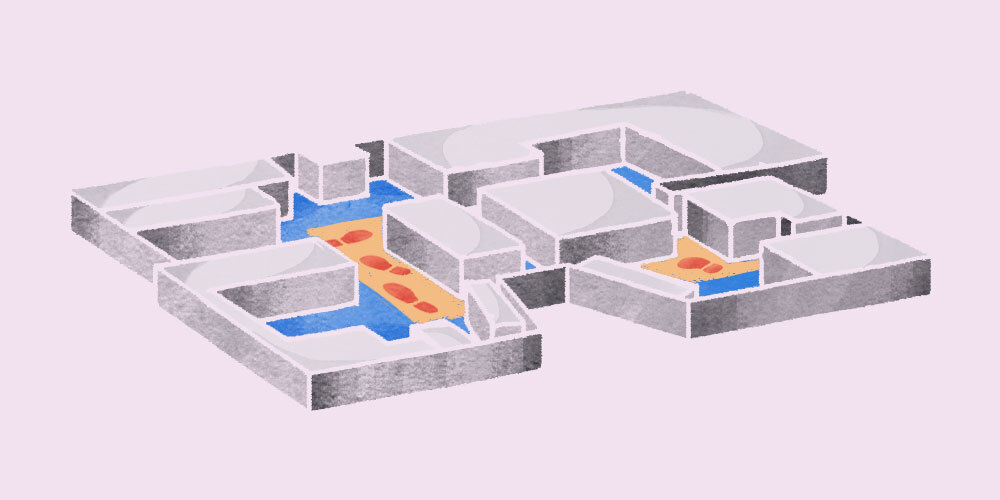How companies are using behavioral data to inform office design

Using sensors that track how people move around in the office, is becoming a go-to method for companies that want to redesign their workspaces to suit modern needs.
Not only are office occupancy rates rarely at 100% but when people are in the office they are also using the workspace differently compared to before the pandemic. To attract people to come into the office, companies are increasingly relying on employee behavioral data to ensure the space provides what workers need when they’re there.
Anonymous people sensing and occupancy detection platform Butlr is among the companies working with clients to do this. For one London-based fintech client, which has 8,000 employees, Bultr placed 80 thermal sensors strategically throughout the 8,094-square-foot office. The fintech client wanted to consolidate from the three floors it used to occupy, to two floors. And to do so effectively it wanted a better understanding of how people used the desk-sharing areas and meeting rooms, and general footfall so they could improve any underused areas.
Working with the client, Butlr collected and analyzed the data for six months. That process highlighted that certain private meeting rooms were being misused for individual focus work, rather than collaborative sessions. That showed the fintech client that there was a need for additional deep-work modules and it redesigned the space accordingly.
“Companies have to use data to figure out how to improve their team experience when getting back to the office, and also see where they can cut to save money,” said Honghao Deng, CEO and co-founder at Butlr.
Butlr is working with over 80 companies, including big tech and Fortune 500 companies, to help them understand how to best use their office space, and help them consolidate where needed, Deng said.
“We find CEOs are trying to bring people back, but CFOs will be looking at the cost from earning reports,” said Deng. “People want to cut on costs because overall the footprint of utilization for office spaces is still pretty low. They’re trying to do the consolidation without stepping on the CEOs’ toes. So the C-suite has to ask, how do we efficiently bring people back, create those awesome interactions, while considering the office footprint.”
Historically, the most common way for employers to track employee movement was via the scanning of ID badges at office entrances. But tracking people’s movement inside an office is a more recent concept.
“A lot of workspace managers want to know how much space they actually need,” said Jiani Zeng, co-founder and chief product officer at Butlr. “Do you need more desks, phone booths, soft seating? What kind of ratio?”
Zeng said most of Butlr’s clients have an average office occupancy rate of below 15%. “They know the number of people coming to the office, but they don’t know how they’re using different spaces and functions,” said Zeng. “Big tech companies are laying people off, creating less people using the space. They need real data to give real answers to uncertainty so they can make a decision on how much space they need to redesign the office so it’s functional for people coming.”
More recently, other companies which have similar technology to Butlr also began to cater to the corporate world. But concrete examples of how the data has altered office redesigns have been few and far between.
“Down the line, I do see this becoming a standard where the architecture and design firms blend in this kind of office automation with their ideas,” said Deng. “When you design something, you usually find out years later whether or not it works. With the data, they can make it more responsive and understand how people use the space and improve the process.”
Other companies are also trying to figure out how to track behavioral data for better insights. Framery, a company that designs workplace soundproof pods and booths, gathers usage rates on behalf of companies including LinkedIn, H&M and Puma. Framery can provide data on how many people use the pods, and for how long.
Over time, managers can then benchmark trends or patterns in usage rates between specific months or periods and assess how these have changed over time. For example, at Puma, pods were being underused simply because there were fewer people in the office as a result of hybrid working, according to Arto Vahvanen, head of digital offerings and customer experience at Framery.
“Some customers were going to purchase more pods, but they saw they could pull pods from different floors,” said Arto Vahvanen, head of digital offerings and customer experience at Framery. “That was a result of them seeing some parts of the office were less used. Some of the teams hadn’t returned to the office as much as they were thinking. They moved the pods from that area to a new building or location to balance the load.”
That’s one reason Erin McDannald, CEO and co-owner of Lighting Environments and its sister company, Environments, have been using data to understand how their 80 employees use their two office locations. Through data, they found that while they have 50% office occupancy, those coming in are using 100% of the space.
“We found that people want to stretch out and move,” said McDannald. “That’s different to pre-pandemic. People need a place where they can walk and talk.” An area of the office that was under renovation was open but without any furniture in it. From observing the heatmaps, McDannald could see people were using it as a runway. “They would put their headphones in, talk on the phone and would walk. Every new office needs a walking track because we all got up and moved during the pandemic,” she added.
McDannald also found through the data that people liked to sit near windows for natural light, have access to fresh air and open doors, that people would avoid areas of the office entirely if they were too hot or cold, and so on.
“We’ve been missing the mark on what humans really need in built environments,” said McDannald. “It deserves another look to understand what they’re actually doing and what they’re actually telling us they need.”


